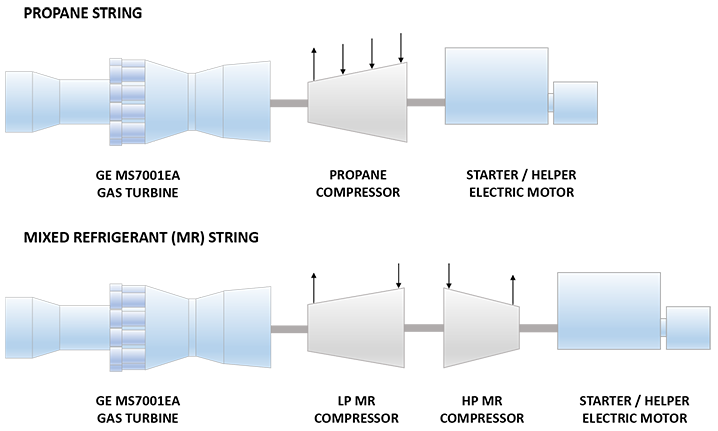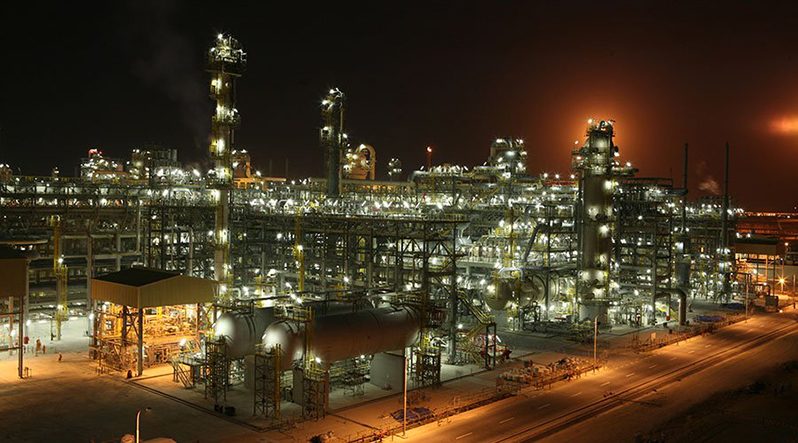In 1971, natural gas was discovered in the North Field, which is spread over a 6000 square kilometre area off the northeast coast of Qatar. The importance of this monumental discovery took a long time to percolate into commercial gain. Multiple drilling appraisals over 15 years confirmed that the field was the largest non-associated natural gas field in the world, home to almost 10% of the world’s known reserves. Suddenly Qatar found itself as owner of the third largest gas reserves in the world, after Russia and Iran. The North Field Bravo off-shore complex (NFB) was commissioned in 1996 and the RasGas Alpha off-shore complex (RGA) was started in 1999. The off-shore operations now comprise of 209 wells, which supply 18.5 billion cubic feet of sour gas daily.
In the mid-1990s Qatar invested millions of dollars to develop the port facilities and associated infrastructure at Ras Laffan, to facilitate the exploration, storage and export of its massive natural gas resources. The location, 80 kms north-east of Doha, was in ideal proximity to the North Field, as well as advantageously positioned on international maritime routes to the Far East and Europe. The on-shore operations at Ras Laffan Industrial City are spread over 7.80 square kilometres. By 2005 the port had shipped over 1000 cargos and by 2015 this number rose rapidly to 5000.
The history of LNG in Qatar started with the establishment of Qatar Liquefied Gas Company Limited (Qatargas 1) in 1984. In 1996, Qatar received delivery of its first LNG Vessel – “Al-Zubara”. Initially the operations proceeded at a glacial pace, with eight years underway before the first Sale and Purchase Agreement (SPA) was signed and 12 years for delivery of first LNG cargo. However, by 2010, Qatar established itself as the largest producer of LNG in the world with a capacity to export 77 MMTPA of LNG.
In 1993, the Ras Laffan Liquefied Natural Gas Company Limited (RL) was founded to build a separate LNG plant, south of the existing Qatargas 1 facility. 2 trains of capacity of 3.3 MMTPA each were planned. RasGas signed an agreement with Korea Gas Corporation (KOGAS) in 1995, committing 2.4 MMTPA of its output. RasGas train1 started production in 1999 and its first LNG cargo was delivered to Korea Gas Corporation (KOGAS) in August 1999. The next year, RasGas train 2 also began operations.
The facility produces 6.6 MMTPA of LNG, in addition to a daily produce of 44,000 barrels of stabilised field condensate, 4000 barrels of plant condensate and 200 tonnes of granulated sulfur. The plant is fed from 3 wellhead platforms with 15 offshore wells of 1.2 billion standard cubic feet per day (bscfd) capacity. The extracted gas and condensate are dehydrated offshore and sent to the facility using a 32-inch diameter, 92-km export pipeline.
In 2018, Qatargas and RasGas operations were merged into one global energy operator – Qatargas. Today the Ras Laffan Industrial City (RLIC) is home to a workforce of approximately 115,000 personnel. Qatargas is working towards Qatarization of its workforce and aims to accomplish over 50% Qatari workers by 2030. There is a strong focus on hiring, training and maintaining Qatari employees. Qatar Petroleum together with US University Texas A&M established, the Ras Laffan Emergency and Safety College for imparting training on industrial, hazardous materials, municipal, rescue and emergency medical services. In line with the goals of Qatar National Vision (QNV) 2030, Qatargas not only strives to exceed regulatory requirements, but also proactively works on initiatives for Green House Gas (GHG) management, sustainable waste management and waste reduction, wastewater management, air emission control and flare reduction. In 2015, the Jetty Boil-off Gas Recovery project (JBOG) was inaugurated in order to mitigate the flaring at Ras Laffan LNG loading berths by 90%.
OWNERSHIP (Equity %)
| Qatar Petroleum | 63.00% |
| ExxonMobil | 25.00% |
| Koras (KOGAS, Samsung, Hyundai, SK Corp., LG International, Daesung Industrial & Hanwha) | 5.00% |
| Itochu Corporation | 4.00% |
| LNG Japan Corporation (Sojitz 50% – Sumitomo 50%) | 3.00% |
General Data
| Estimated Capital Cost (USD) | 1.65 B per Train |
| Plant Type | Onshore Stick-built |
| Plant Stage | Operating |
| Final Investment Decision (FID) Year | 1995 |
| FEED Contractor | Chiyoda Corporation |
| EPC Contractor | JGC Corporation Kellogg Brown & Root, Inc. |
| No. of Trains / capacity | 2 Trains / 3.3 MMTPA each |
| Production Start Year | 1999 (Train 1) 2000 (Train 2) |
| Products | LNG, LPG, Condensate, Sulfur |
| Gas Type | Non-associated Gas (NAG) |
Technical Data
| Cooling Media | Fresh water cooling (Fresh water cooled by sea water) |
| Liquefaction Technology | APCI AP-C3MR™ |
| Refrigeration Train Details: | |
| Propane String | |
| Driver | GE MS7121EA DLN1 (Frame 7EA) Heavy Duty Gas Turbine (Upgraded from standard combustors) |
| Propane Compressor | 88M7-5 Elliott Horizontally Split Centrifugal Compressor |
| Starter/Helper Motor | 8 MW Synchronous Motor with VSD System |
| Mixed Refrigerant (MR) String | |
| Driver | GE MS7121EA DLN1 (Frame 7EA) Heavy Duty Gas Turbine (Upgraded from standard combustors) |
| Low Pressure (LP) MR Compressor | 88M4 Elliott Horizontally Split Centrifugal Compressor |
| High Pressure (HP) MR Compressor | 60MB6 Elliott Radially Split Centrifugal Compressor |
| Starter/Helper Motor | 8 MW Synchronous Motor with VSD System |
| Power Generation | 4 x GE PG6581B DLN1 (Frame 6B) Heavy Duty Gas Turbines (Upgraded from standard combustors) |
Refrigeration Train Configuration

Key Facts
- RasGas 1’s key customers are KOGAS of Korea and Endesa of Spain. KOGAS signed an SPA for 4.92 MMTPA LNG to be delivered between 1999-2024 on DES-basis (Delivered Ex Ship). Endesa committed to purchase of 0.74 MMTPA LNG for deliveries between 2005-2025 an FOB-basis (Free-on-Board).1
- The RasGas 1 plant has facilities for inlet gas reception and treatment, condensate stabilisation, gas liquefaction, sulphur recovery and loading along with the requisite utilities and off-site systems and infrastructure. In June 1999, RasGas 1 loaded its first spot cargo on LNG tanker ‘GIMI’ for shipment to KOGAS, Korea.2
- RasGas 1 (RG1) project includes the Offshore Platform constructed by McDermot in the North Field, the Pipeline constructed by Saipem to connect the Offshore Platform to the Onshore Plant, and the Onshore Facilities constructed by JGC & KBR JV. The contractors completed and commissioned the project in February 2000, one month ahead of schedule.3
- RasGas 1 employs the APCI Propane/Mixed Component Refrigeration (MCR) Process. The plant facilities include: 3
> Frame 7 gas turbines technology for the Mixed Component Refrigerant (MCR) and Propane compressors
> 4 GE Frame 6 Gas Turbine Generators for power generation
> 2 Diesel Generators for start-up
> 2 Diesel Engine Driven Sea Water Fire Pumps for use during start-up
> Fresh Cooling Water system for Refrigerant Compressor inter/after coolers
> Other utilities such as Nitrogen Generator, Desalination Plant, HRSG, Waste Water Treatment Units, Boiler Feed Water Treatment
> 5 km Pipelines for LNG, Condensate and Sea Water
> 3 LNG Storage tanks of capacity 140,000m3
> Condensate Storage Tanks
> Port loading facilities - RasGas 1 experienced minor problems during activities leading to start-up of the plant. These included level control issues in the Merichem Unit and plugging of the valve cages in the recycle lines to the compressor. However, significant time was made up on account of a well thought out defrost system, which cut the dry-out period from 6 weeks to 3 weeks. First LNG was produced on May 23 1999, just eight weeks after Mechanical Acceptance Package (MAP), 5 weeks ahead of planned schedule. 3
- In May 1999, post start-up, RasGas 1 witnessed several mechanical problems: 3
> Multiple failures due to seizures and erratic movements in the cryogenic valves. The cause was attributed to the bushing material and required removal and repair, as replacement was a challenge.
> Seizure of Frame 7 Speed/Stop Ratio Valves (SRV), on both the Propane and the MR turbines. The seizures were attributed to NACE specification valves, which are softer and more prone to scoring, in addition to the manufacturer’s poor QA/QC and construction techniques. The valves were subsequently replaced with Non-NACE valves.
> Inadequate Control Valve Actuators in applications such as air control to the SRU reaction furnace, had to be identified and replaced with more fit for purpose designs. - During the design phase of RasGas 1, dual-shaft industrial gas turbines (GE Frame 5) were a popular choice due to their ability to control the speed of the power turbine independently from the gas generator, resulting in better process and operation flexibility. However, RG1 selected the single shaft Frame 7 gas turbines (GE 7EA 121EA) due to the following factors: 3
> 20-25% reduction in capital cost; both cost per MW as well as installation cost.
> Higher power ratings in Frame 7 turbines, allowing use of fewer units
> 10-15% better specific fuel consumption and lower emissions - Feed gas from North Field Alpha (NFA) contains contaminants of H2S, CO2, and RSH. RasGas employs Shell’s proprietary Sulfinol-D treating process for acid gas and mercaptans removal. To mitigate Sulphur Dioxide (SO2) emission to the atmosphere RasGas deployed Sulphur Recovery Units (SRU) using the SUPERCLAUSTM process. An Acid Gas Enrichment unit (AGE) and a Tail Gas Cleaning Unit (TGCU) were added to achieve over 95% Sulphur recovery . The plant produces 312 tons of solid sulphur per day.3
- Fresh Water Cooling is used for Refrigerant Compressor and other services at RasGas 1. The fresh cooling water is in turn cooled by seawater. The system includes Fresh Cooling Water Tanks, multiple Fresh Cooling Water Pumps, and a battery of 16 plate and frame heat exchangers per train for closed circulation of fresh cooling water. This arrangement was preferred over seawater cooling to reduce downtime which was required to not exceed the Frame 7 maintenance schedule. Fresh water cooling also offers advantages in the form of use of less expensive piping and exchanger materials, as well as reduced possibility of environmental damage on account of leakage from the process.3
- On 25 September 2017, RasGas signed a 15-year agreement with Bangladesh’s state-owned Petrobangla to supply 1.8 MMTPA of LNG between 2018 and 2022 and 2.5 MMTPA of LNG between 2023 and 2032. The cargos will be delivered to Excelerate Energy’s 3.75 MMTPA floating storage and regasification unit (FSRU) – ‘Excellence’, near Moheshkhali Island. This is Qatargas’ first long-term sale to a FSRU in open water, ie. delivery through ship-to-ship transfer (STS) in open water.4,5
- RasGas entered the LNG market claiming one of the lowest cost-per-ton of LNG produced in the industry. RasGas 1 & 2 (RG1 and RG2) were the world’s first LNG plants to use GE Frame 7 driven Propane MR compressor.6
Source:
1. ‘The LNG industry GIIGNL Annual Report 2018’, GIIGNL Website, 2018
2. ‘Qatar Petroleum Annual Report 2007’, Qatar Petroleum Website, 2007
3. Al-Muhannadi H.M. et al. ‘Successful Completion and Initial Operation of The Ras Laffan Onshore Facilities (LNG) Project’, 13th International Conference & Exhibition on Liquefied Natural Gas, Seoul, Korea, May 200
4. ‘Bangladesh Receives First Imported LNG from Qatar’, The Maritime Executive Website, 24 April 2018
5. ‘Landmark LNG Delivery – A First for Qatargas and Bangladesh’ The Pioneer Magazine, October 2018 Issue #155
6. Dr. Akhtar S. ‘Driver Selection for LNG Compressors’, MSE Consultants Website, 14 December 2004






















































